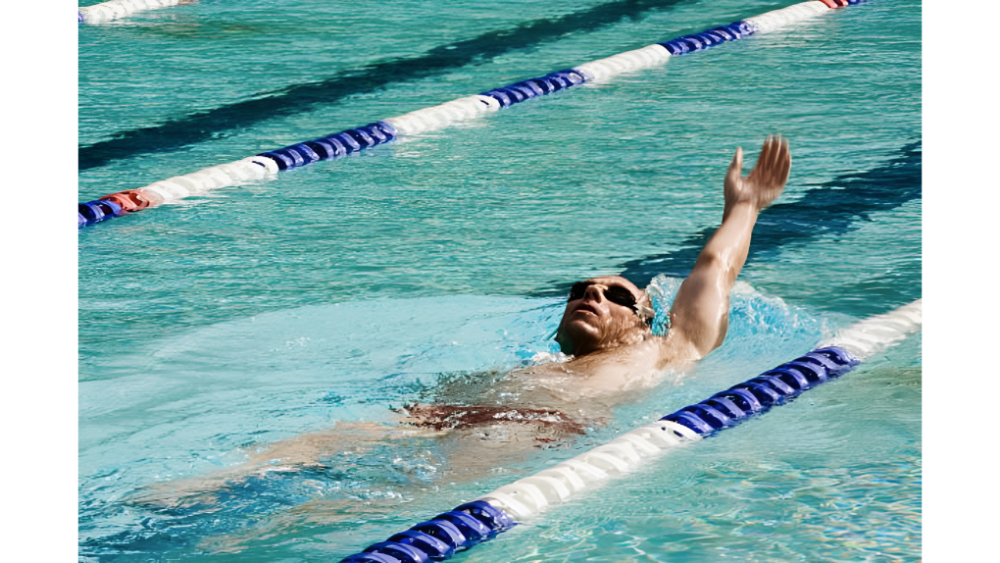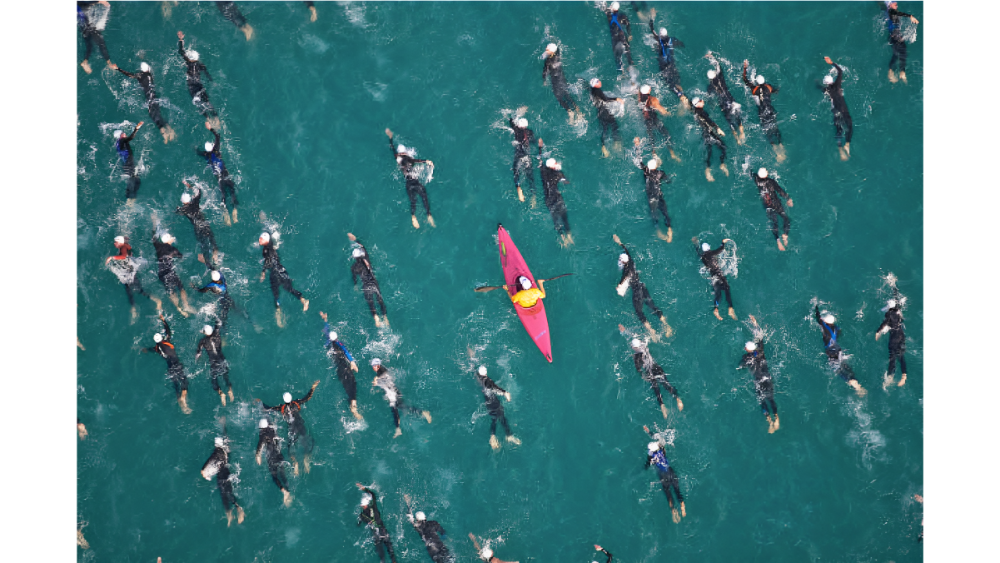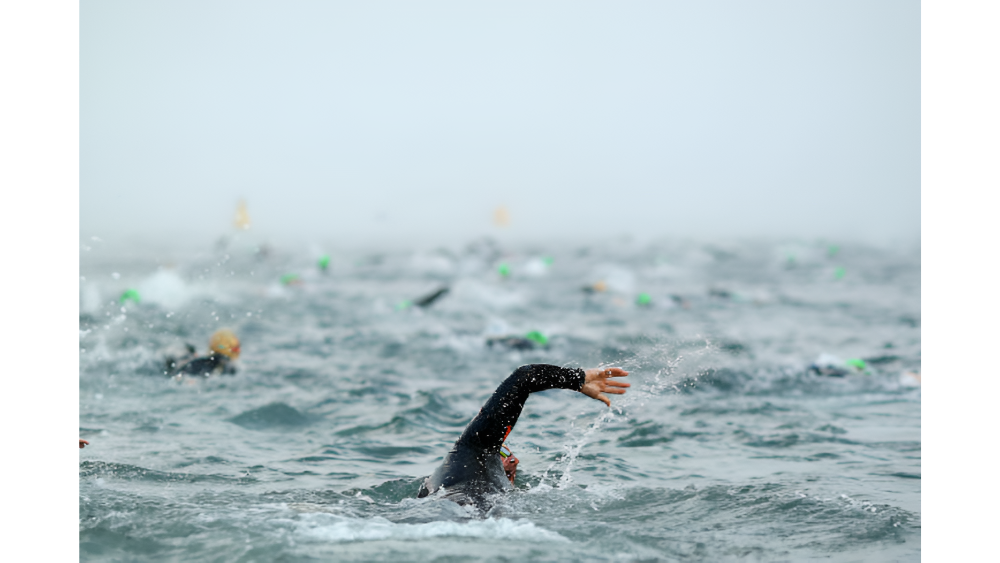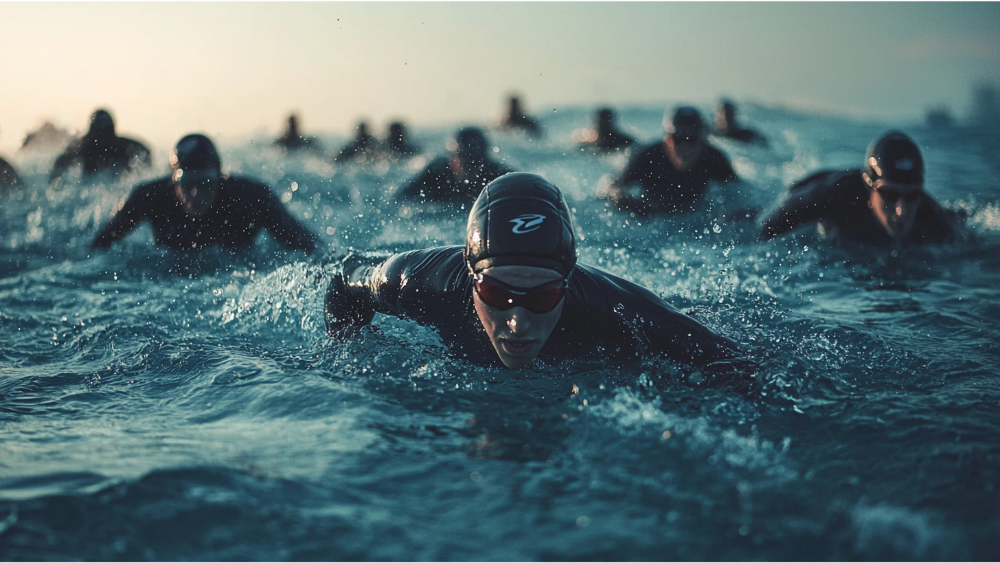When it comes to completing an Ironman, the swim portion is one of the most daunting aspects for many participants. The thought of covering 2.4 miles in open water, often surrounded by hundreds or even thousands of other competitors, can be overwhelming. Freestyle dominates as the stroke of choice in this segment, but a question remains: Do Ironman athletes use backstroke in the water?
This guide delves into whether participants incorporate backstroke, why and when they might choose it, and how each stroke impacts their performance. This in-depth guide will examine whether participants incorporate backstroke, under what circumstances they might choose to do so, and how different strokes influence overall performance.
Overview of the Ironman Swim
What is the Ironman Triathlon?
The Ironman triathlon tests endurance across three disciplines: swimming, biking, and running. Competitors begin with a 2.4-mile swim, followed by a 112-mile bike ride, and finish with a full marathon of 26.2 miles. The swim segment typically takes place in open water, whether a lake, ocean, or river, making it much more challenging than pool swimming.
The Structure of the Triathlon (Swim, Bike, Run)
In the Ironman triathlon, the swimming portion often determines the pace for the rest of the race. Swimmers must complete 2.4 miles, often facing challenges like cold water, currents, and reduced visibility. The overall strategy for many athletes is to conserve energy during the swim so they can excel in the bike and run portions.
The Importance of the Swim Segment in Ironman
The swim segment may only be the first part of the triathlon, but it plays a crucial role in setting the tone for the entire race. For many athletes, maintaining a steady pace while avoiding exhaustion is key to finishing the race strong.
Challenges of Open Water Swimming
Unlike swimming in a pool with lane markers and controlled conditions, open-water swimming can be unpredictable. Competitors face challenges such as choppy water, variable temperatures, and the chaotic mass of swimmers around them. Additionally, navigation becomes a significant issue in the absence of clear lanes.
Techniques to Succeed in the Ironman Swim
Freestyle is the go-to stroke for most competitors because it is the fastest and most energy-efficient. However, some athletes may switch to other strokes, such as breaststroke or backstroke, for short intervals to rest or reorient themselves.
Can You Backstroke in an Ironman?

Official Rules Regarding Swim Strokes
The official Ironman rules do not restrict which strokes participants can use during the swim. Most triathlon organizations, including Ironman and USA Triathlon, allow participants to swim using any stroke, whether it’s backstroke, breaststroke, or even butterfly. The only requirement is that athletes must complete the swim under their own power.
Are All Swimming Strokes Permitted?
Ironman races allow athletes to use any stroke, but most prefer freestyle because it delivers the best speed and efficiency. Although athletes rarely use backstroke for long distances, they often switch to it briefly to recover when necessary. Depending on where you race, you may have to alert race officials beforehand that you are going to use backstroke.
Backstroke vs. Freestyle: What’s More Efficient?
Freestyle, or front crawl, delivers the fastest speed, making it the top choice for nearly all competitive swimmers. Backstroke, on the other hand, is much slower. While backstroke allows the swimmer to breathe more easily with their face out of the water, it is less efficient in terms of speed and energy consumption. Backstroke also makes it difficult to sight, which is crucial in open water
Situations Where Athletes Might Opt for Backstroke
Resting and Recovery in Open Water
Backstroke can be a useful tool for athletes who need a moment to recover without stopping entirely. During the swim, it is common for athletes to feel overwhelmed, especially if they are dealing with fatigue, cold temperatures, or crowded waters. Switching to backstroke can provide a momentary break, allowing swimmers to catch their breath while still making forward progress
Visibility and Sighting in Open Water
One of the biggest challenges in open water swimming is navigation. In a pool, swimmers rely on lane markers to stay on course, but in open water, there are no such markers. Freestyle swimmers must periodically lift their heads to sight buoys or landmarks to stay on track. In contrast, backstrokers cannot see where they are going, making it much harder to swim in a straight line
Why Do Most Ironman Athletes Avoid Backstroke?

Performance Considerations
Speed and Efficiency
Freestyle is far superior to backstroke in terms of speed. Competitors aiming to complete the swim leg quickly and efficiently rely on freestyle because it generates more forward momentum with less energy. Backstroke, while easier on the respiratory system, creates more drag and moves the swimmer slower through the water
Energy Conservation and Muscle Fatigue
Athletes favor freestyle over backstroke primarily because it conserves more energy. Ironman athletes must conserve as much energy as possible during the swim to have enough reserves for the bike and run portions. Freestyle allows for a steady pace and smooth, continuous motion, whereas backstroke can tire the legs and lower back muscles more quickly
Navigation and Sighting Challenges with Backstroke
Difficulty of Keeping a Straight Line
Swimming in a straight line is crucial for minimizing the distance covered during the Ironman swim. Backstroke makes this particularly challenging because the swimmer cannot see forward, often leading to a zig-zagging path. This not only adds distance but can also lead to collisions with other swimmers
The Role of Backstroke in Training for Triathletes

Incorporating Backstroke for Recovery and Endurance
How Backstroke Can Aid Recovery
Although athletes rarely use backstroke during the race, they often incorporate it as a key element in their training. By incorporating backstroke into training sessions, athletes can balance their muscle use and reduce the risk of injury. Backstroke targets different muscle groups than freestyle, which can provide relief during long swim sessions
Building Endurance Through Stroke Variation
Athletes who alternate between different strokes in training, including backstroke, can build endurance more effectively. By switching strokes, they allow different muscle groups to recover while continuing to swim. This technique can be particularly useful in helping athletes build the stamina necessary for the 2.4-mile Ironman swim
When Backstroke Might Be a Strategic Choice in Ironman
Special Circumstances
Backstroke may be a viable option in certain circumstances during the Ironman swim. If a swimmer becomes disoriented, panicked, or needs a quick break, switching to backstroke can serve as an effective strategy for recovery. It allows for easier breathing and a moment to reset without stopping entirely. Athletes should use backstroke only briefly, as the reduction in speed can significantly affect their overall race time.
Other Stroke Options for Ironman Athletes
The Popularity of Breaststroke for Sighting
Sighting Benefits
Breaststroke is another stroke that some Ironman participants use when they need to sight or rest. Unlike freestyle, breaststroke allows swimmers to keep their head above water, making it easier to spot buoys and stay on course. This makes breaststroke a popular choice for beginners or those struggling with navigation
Slower, but Steadier: Why Breaststroke is Common for Beginners
For athletes who feel less confident in their swimming, breaststroke offers a safer alternative. Although slower than freestyle, it provides consistent breathing and greater control, helping reduce anxiety and improve comfort in open water conditions. This stroke allows swimmers to maintain visibility and manage their pace effectively, especially during longer distances.
The Gold Standard for Ironman Swimming
Effectiveness in Open Water
Ironman athletes overwhelmingly favor freestyle because it offers unmatched speed and efficiency in open water. This stroke provides smooth, continuous movement, making it ideal for the 2.4-mile swim. When paired with proper breathing and sighting techniques, freestyle enables competitors to maintain a fast, steady pace while conserving energy for the bike and run segments.
For any serious Ironman competitor, mastering freestyle is critical, as it significantly reduces swim time and enhances overall performance. Consistent training focused on refining technique, endurance, and navigation is essential for athletes aiming to maximize their efficiency in the water.
Conclusion: Is Backstroke a Viable Option for Ironman?
Weighing the Pros and Cons
Although athletes are allowed to use backstroke in Ironman races, most avoid it due to its impracticality for maintaining competitive speed. The slower pace, added drag, and challenges in navigating straight lines make backstroke less effective for covering long distances quickly. However, backstroke can serve as a useful recovery strategy in specific situations, such as when athletes need to catch their breath or reorient themselves during the swim. Despite its limitations, backstroke remains a helpful tool for moments of rest, but athletes typically rely on faster strokes like freestyle for the bulk of the race.
Final Advice for Ironman Participants
For most athletes, mastering freestyle is the key to success in the Ironman swim. Athletes should consider backstroke a backup option for recovery rather than relying on it as their primary stroke for propulsion. Focus on building endurance and technique in freestyle, while incorporating other strokes like backstroke and breaststroke into your training for balance and recovery
Frequently Asked Do Ironmen Backstroke in the Water?

Can I switch strokes during the Ironman swim?
Athletes have the flexibility to switch between different strokes, like backstroke or breaststroke, at any time during the Ironman swim, allowing them to adjust their pace and recover as needed.
What are the official rules on using backstroke in triathlons?
Athletes can use backstroke in Ironman races, but it is less common because of its slower speed and the challenges it presents in navigation.
How can I take a rest during the Ironman swim if I’m feeling exhausted?
Athletes can briefly switch to backstroke or breaststroke for recovery during the Ironman swim, allowing them to rest without halting their forward progress or completely stopping.

Leave a Reply